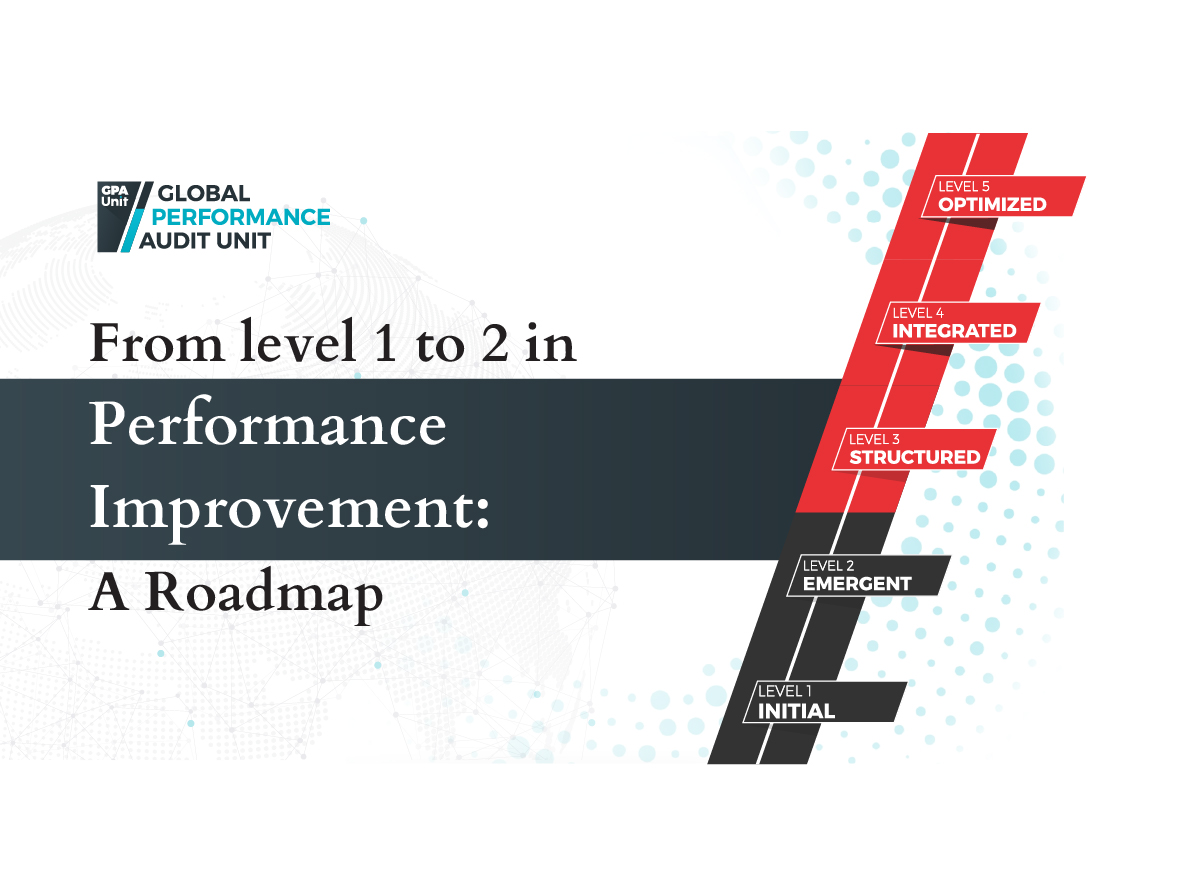From Level 1 to Level 2 in Performance Measurement

This article continues our “From Level 1 to Level 2” series, building on the foundations laid in Strategic Planning by turning our focus to Performance Measurement—the next critical capability in achieving structured, strategy-aligned performance management systems.
Performance measurement is an enabler of strategic execution, accountability, and continuous improvement. Without it, organizations operate in the dark, unable to assess whether their efforts are driving results, aligning with objectives, or creating impact. At its best, performance measurement turns data into insight through clearly defined performance metrics, helping leaders course-correct in real time and fostering a culture of evidence-based decision-making.
At the GPA Unit, we define performance measurement as a capability composed of six dimensions: KPI Selection, KPI Documentation, Target Setting, Data Gathering, Data Visualization, and KPI Governance. Together, these dimensions determine how well an organization can define, track, and act on performance information.
Yet in many organizations, performance measurement is still in its infancy. KPIs are improvised, data is fragmented, and governance is unclear. What does it take to move from Level 1 (Initial) to Level 2 (Emergent) in performance measurement maturity?
Whether you're a strategy manager, performance lead, or senior decision-maker, understanding this transition is essential for building a system that supports—not hinders—strategic progress.
The missing foundations
At Level 1 Maturity in Performance Measurement, organizations operate in a reactive, disconnected environment. While scorecards may exist and leaders might ask for “KPIs,” the reality on the ground is often confusing and inconsistent.
One of the clearest signs of this immaturity is the overreliance on financial indicators. This pattern is closely tied to early-stage Strategic Planning practices, where leadership typically lacks a structured vision. When the only direction is to “make money,” then naturally, that becomes the only thing measured. Financial data takes center stage, while other critical performance areas—such as internal efficiency, customer experience, or employee development—are left in the dark.
But the problem runs deeper than just what gets measured. At Level 1, organizations also struggle with how performance is defined. Without a shared methodology or standard, anything can be labeled a KPI—from tasks (“submit report by Friday”), to outputs (“number of emails sent”), to project milestones (“complete initiative X”). This lack of clarity creates a chaotic measurement environment where teams are essentially speaking different languages. There’s no baseline for comparison, and no alignment across departments or levels.

This confusion is further amplified by the absence of KPI documentation. There is no central repository (KPI Library) to store KPI documentation forms, primarily due to the absence of a standardized template, and no agreed-upon terminology. As a result, employees may refer to the same indicator using different names—or worse, use the same name to mean different things. This makes collaboration nearly impossible and undermines trust in the data.
And even when some form of KPIs exist, target setting remains a major challenge. In many cases, targets are missing entirely. Where they do exist, they tend to be vague, arbitrary, or binary (“yes/no”). It’s not that leaders don’t want to set meaningful targets—it’s that the organization lacks the processes and references to define what “good” looks like. There is no benchmarking, no performance history, and no consistent method for calibration.
All of this contributes to an unreliable approach to data gathering. At Level 1, data is collected manually—if it’s collected at all. There’s no automation, no assigned data custodians, and no regular schedule. Collection often happens reactively, in response to a request from leadership, rather than as part of an ongoing performance cycle. In many cases, data is captured in different formats, across disconnected tools, or simply not captured at all.
Naturally, this makes data visualization difficult, if not impossible. While many Level 1 organizations aspire to have dashboards and performance reports, the lack of consistent, structured data means there’s little to visualize. Charts and tables may exist, but they’re often incomplete, outdated, or poorly designed. Rather than supporting decision-making, these tools become static reports that are hard to interpret and quickly forgotten.
Underlying all of this is the absence of governance. At Level 1, performance measurement is no one’s formal responsibility. There are no designated roles like KPI owners or data custodians. There’s no training in place to build measurement capabilities. And there’s no formal review or feedback process to improve the system over time. Much like in Level 1 Strategic Planning, performance measurement here is informal, siloed, and dependent on individual initiative rather than institutional structure.
In short, Level 1 is defined by ambiguity. There may be isolated efforts, but without consistency, accountability, or shared standards, performance measurement remains a scattered practice rather than a strategic asset.
The key milestones of level 2
Reaching Level 2 in Performance Measurement Maturity marks a shift from fragmented practices to early structure. Organizations at this stage begin building a system that not only tracks performance more deliberately, but also supports alignment, transparency, and decision-making. While still in its formative phase, Level 2 is where measurement starts to take shape as a reliable management tool.

The first signs of progress often appear in KPI selection. Rather than choosing indicators based on convenience or instinct, organizations begin using structured discussions—sometimes supported by training or basic tools—to guide the process. There’s growing recognition that KPIs should reflect what the organization is actually trying to achieve. Objectives start to shape measurement, and some form of alignment emerges. While the process may still be inconsistent, the intent is clear: performance metrics and KPIs should be selected with purpose, aligned with what the organization actually wants to achieve.
As KPI selection becomes more thoughtful, organizations also begin to balance their measurement focus. Financial indicators still play a role, but they are increasingly complemented by metrics tied to customer satisfaction, internal processes, or employee development. This broader view helps organizations track the health of their strategy—not just its bottom-line results.
Clarity also begins to emerge in defining what a KPI is—and what it is not. At Level 2, teams start to differentiate between goals, tasks, and indicators.
For example, “Improve client onboarding speed” might be the objective; “Average time to onboard a new client” becomes the KPI; while “Send welcome email within 24 hours” is a supporting task.
With a more defined KPI set, target setting begins to evolve. Instead of setting arbitrary numbers or relying on binary completion checks, organizations start introducing basic internal or external benchmarks. Targets may still be negotiated informally, but they’re increasingly based on performance history, industry norms, or strategic ambition. For the first time, targets provide direction rather than just acting as placeholders.
A significant milestone at Level 2 is the establishment of a repeatable data collection process. Data is no longer gathered “when someone asks for it”—it follows a set rhythm. While collection may still be manual, and systems may not yet be automated, the practice becomes embedded in the organization’s routine. Ownership of data collection begins to shift from individuals to roles, and performance data becomes more available and more trusted.
This new data reliability paves the way for early-stage visualization efforts. Scorecards, dashboards, and performance reports are introduced—often in their simplest form. While not yet optimized or polished, these tools allow leaders and teams to actually see performance patterns. Even a basic chart can spark more meaningful conversations than rows of raw data.
Governance, too, takes its first real form at Level 2. Organizations begin assigning roles and responsibilities—perhaps a KPI owner, a performance lead, or a data custodian. There may not be a complete governance framework, but at least some accountability structures are in place. A simple guide or manual might be developed, and key staff begin to receive introductory training on performance measurement—often just a few hours a year, but enough to build awareness and consistency.
Together, these milestones create a foundation for future growth. While measurement systems at Level 2 are still under construction, the shift from ad hoc practices to structured habits enables organizations to track progress more confidently, support decision-making more consistently, and align teams more effectively.
The first steps towards performance measurement maturity
Level 2 in Performance Measurement is about progress, not perfection. It’s where organizations move from reacting to results toward intentionally tracking them. From scattered reports to structured routines. From measuring what’s easy to measuring what matters.
By building early standards around KPI selection, target setting, data collection, and visualization, organizations create the conditions for performance measurement to support—not just report on—strategic progress. These foundational steps bring clarity, consistency, and credibility to how performance is discussed and acted on.
Most importantly, Level 2 marks the shift from measurement as a checkbox exercise to measurement as a management tool. It’s the first stage where data begins to drive decisions, and where teams start speaking a shared performance language.
Organizations that commit to this transition position themselves for smarter choices, better alignment, and a more accountable, results-driven culture. And while challenges remain, the path toward maturity is no longer unclear—it’s underway.
| DATE | May 09th, 2025 |
| Category | Blog Posts |
| Reading Time | 6 |




